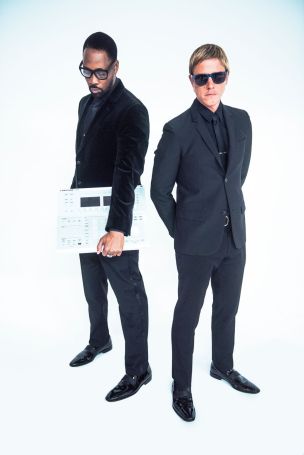By Joel Francis
The Kansas City Star
As the guitarist and singer for Interpol and mastermind behind the Wu-Tang Clan, Paul Banks and the RZA, a.k.a. Bobby Steelz, have filled and commanded spaces far bigger than the intimate Tank Room. Wednesday night, the duo treated a sold-out crowd to a masterful mashup of indie rock and hip-hop.
The seemingly disparate musical approaches have driven each artist to deliver some of their best work. On party tracks like “Sword in the Stone,” Banks’ soulful indie rock chorus played off RZA’s aggressive verses. Other times, formula reversed itself when RZA’s insistent contribution punctuated Banks moody vocals.
 The hourlong set comprised all but one song of the duo’s debut album, and ignored their other groups. The night started with the soulful yet ominous “Point of View” before exploding with “Ana Electronic.” Fans may not have been able to sing every word, but they had no problem swaying to the beat.
The hourlong set comprised all but one song of the duo’s debut album, and ignored their other groups. The night started with the soulful yet ominous “Point of View” before exploding with “Ana Electronic.” Fans may not have been able to sing every word, but they had no problem swaying to the beat.
The room reached fever pitch with “Giant,” the album’s lead track, which has been generating airplay and online buzz. As Banks sang “everything is shaking through the walls” on the chorus, the floor was literally pulsing with the rhythms of everyone dancing.
RZA took the stage holding a large bottle of vodka. After several liberal pulls, he distributed cups along the front row and filled them before passing the bottle into the crowd. Later in the show, he popped open a bottle of champagne and sprayed the room.
A woman on the front row and her companion were singled out by RZA to set up “Can’t Hardly Feel,” a song about loving someone who belongs to another.
While the RZA had the flash and energy to command attention, it was in moments like this that Banks quietly stole the spotlight. His plaintive tenor drove not only “Can’t Hardly Feel,” but the philosophical “One by One” and the potent “Speedway Sonora.”
Walkmen drummer Matt Barrick supported the duo, turning the group into an all-star trio. His tight bossa nova rhythms anchored the song “Wild Season” and showed why RZA later called him the human drum machine. The three stretched out instrumentally only once, during “Conceal,” when Banks’ lengthy guitar solo gave way to RZA’s keyboard/organ.
Setlist: Point of View, Ana Electronic, Love and War, Sword in the Stone, Wild Season, Conceal, Speedway Sonora, One By One, Can’t Hardly Feel, Giant, Anything but Words.
Keep reading
Review: Snoop Dogg with Method Man and Redman
Album review – “Stax: The Soul of Hip-Hop”
Peter, Bjorn and John Heart Hip Hop













